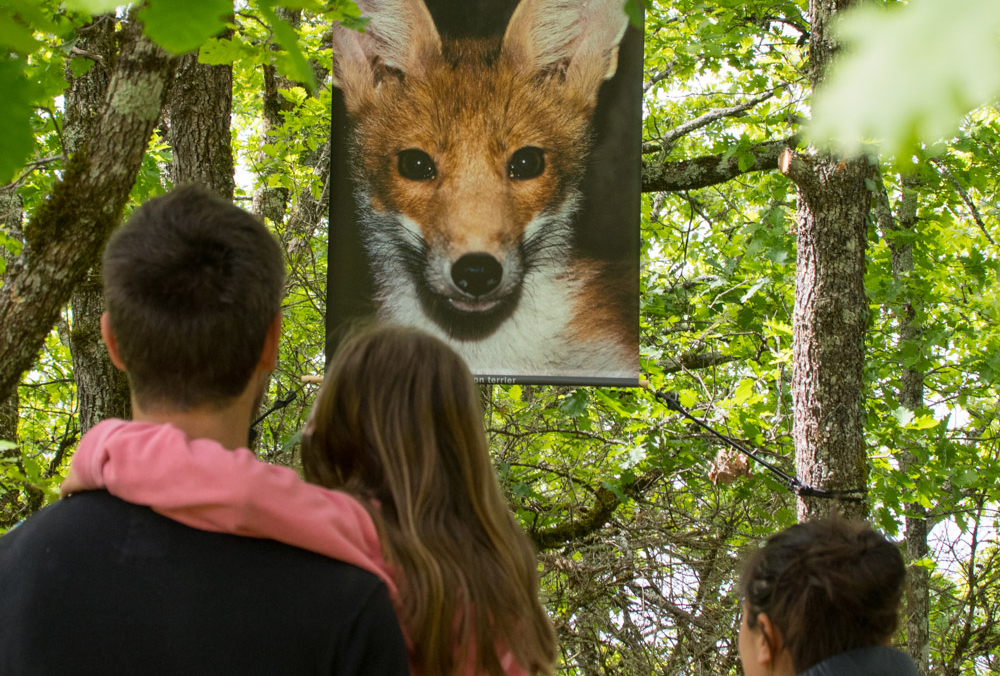
C'est 1 km de promenade facile en sous-bois, en accès libre permanent. Trente grandes photos dans les arbres ponctuent la promenade et vous font découvrir les habitants sauvages des lieux.
Il est possible de réserver une visite guidée avec le photographe animalier auteur des photos. Tel: 06.82.13.93.54
An easy 1 km walk through woods, open 24/7, free of charge. 30 giant photos displayed high in the trees on this nature trail for you to discover the fauna and flora of the area.
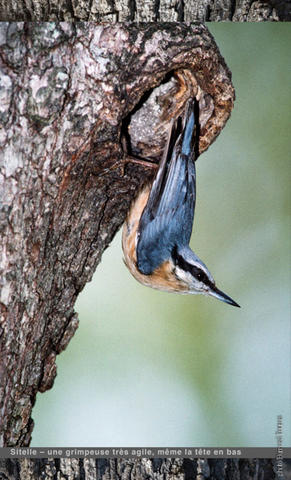
Sitta europaea
SITTELLE TORCHEPOT – UNE GRIMPEUSE TRES AGILE, MEME LA TÊTE EN BAS
Pour se nourrir, elle chasse les insectes dans l’écorce des arbres. Pour se loger, elle profite du travail des pics et, si le trou est trop grand pour elle, elle le rétrécit en maçonnant tout l’arrondi avec de la boue. Il est donc facile de reconnaître l’entrée de son nid.
A savoir : très bruyante ; agressive à la mangeoire avec les autres oiseaux.
NUTHATCH – VERY AGILE, FORAGES DESCENDING TREES HEAD FIRST AS WELL AS WHEN CLIMBING
Feeds on insects from the bark of trees. Nests in tree holes, usually old woodpecker nests. If the entrance to the hole is too large, the female plasters it with mud to reduce its size, making the entrance to the nest easy to spot. Very vocal; readily visits bird tables displaying aggressive behavior to other birds.
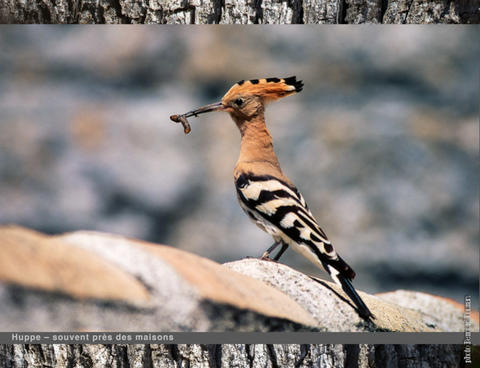
Hupupa epops
HUPPE FASCIEE – SOUVENT PRES DES MAISONS
Partie d’Afrique tropicale, elle arrive ici en mars avril pour nicher dans un arbre creux ou une anfractuosité de mur. C’est au sol, dans l’herbe rase, qu’elle capture les gros insectes dont elle se nourrit.
A savoir : Chant facilement reconnaissable : séries de houp! houp! houp ! souvent trisyllabiques.
HOOPOE – OFTEN FOUND CLOSE TO HOUSES
Migrates from tropical African, arriving here in March and April to nest in a hollow tree or a hole in a wall. Forages on lightly vegetated ground for the insects it feeds on. Its call is easily recognizable, typically a trisyllabic oop-oop-oop.
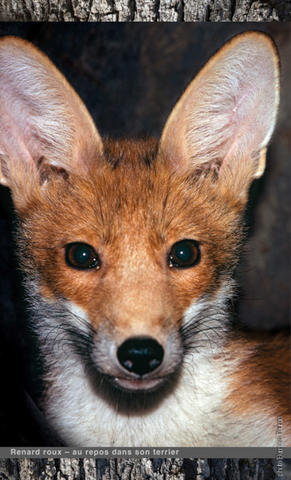
Vulpes vulpes
RENARD ROUX – AU REPOS DANS SON TERRIER
Plutôt crépusculaire et nocturne, très discret, il a un régime alimentaire très varié : rongeurs, fruits, œufs, lapins, oiseaux, vers de terre, insectes, glands,… Il vit dans un terrier qu’il a creusé lui-même à flanc de talus ou qu’il emprunte au blaireau.
A savoir : Les renardeaux sont élevés par les deux parents mais c’est surtout le mâle qui apporte les proies. Ils restent avec leur mère jusqu’en automne.
RED FOX –RESTING IN ITS DEN
Preferring to hunt discreetly in the early morning hours before sunrise and in late evening, the fox has a highly varied diet, including rodents, fruit, eggs, rabbits, birds, earth worms, acorns… Lives in dens either previously dug by a badger or which they dig themselves into the side of a bank. The cubs (known as kits) are cared for by both parents, but the male is the main provider of prey. They will stay with their mother until the Autumn.
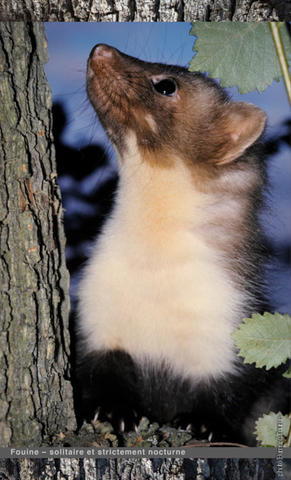
Martes foina
FOUINE – SOLITAIRE ET STRICTEMENT NOCTURNE
Très curieuse, elle grimpe bien mais se déplace surtout au sol. Elle se plaît dans les arbres creux mais aussi dans les granges et les greniers où elle chasse les rongeurs. Sa portée est de trois ou quatre petits par an et elle vit une douzaine d’années.
A savoir : De la même famille (mustélidés) que le putois, la martre et la belette.
BEECH MARTEN – SOLITARY AND STRICTLY NOCTURNAL
Very inquisitive, an agile climber but moves around mainly on the ground. Will live in hollow trees but also in barns and attics where it can hunt rodents. Annual litters of three or four ”kits” are born in early Spring. Lives for about twelve years. A member of the Mustelidae family, which includes polecats, ferrets, mink, and weasels.
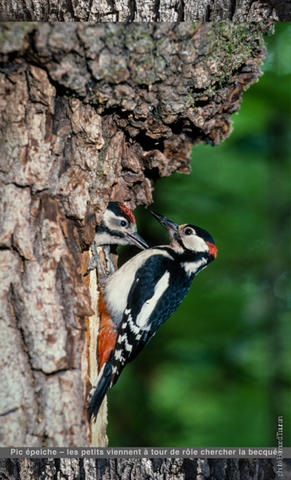
Dendrocopos major
PIC EPEICHE – LES PETITS VIENNENT A TOUR DE RÔLE CHERCHER LA BECQUEE
Plutôt insectivore en été et végétarien en hiver. Il produit son appel caractéristique en tambourinant en rafale sur des branches mortes. Mais il ne creuse pas beaucoup et préfère utiliser un nid creusé par son cousin, grand entrepreneur, le pic vert.
A savoir : Se tient verticalement sur les troncs en s’appuyant sur sa queue aux plumes très robustes.
GREAT SPOTTED WOODPECKER – CHICKS TAKING IT IN TURN TO FEED FROM BOTH PARENTS
Feeds mainly on insects in summer and on plants in winter. Its characteristic call is produced by repeated hammering or drumming on dead wood. Nevertheless, it rarely makes holes for itself, preferring to use a nest dug out by its near relation and great entrepreneur, the European green woodpecker. Perches vertically in trees using its very stiff tail feathers as a prop against the trunk.
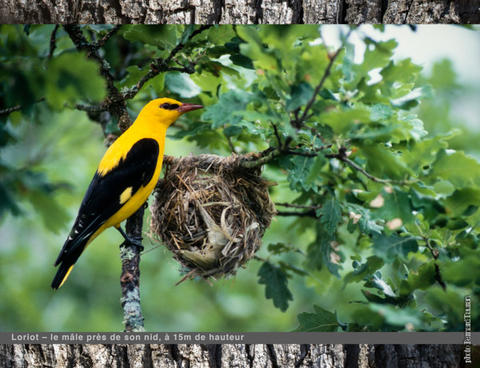
Oriolus oriolus
LORIOT D’EUROPE – LE MÂLE PRES DE SON NID A 15M DE HAUT
C'est un visiteur d'été. Début mai, il se signale par son chant sifflé très reconnaissable. Malgré ses couleurs voyantes, on ne l’observe pas souvent car il ne quitte pas la cime des arbres où il fixe son nid hamac à une branche fourchue horizontale.
A savoir : Régime alimentaire à base de fruits et d’insectes des cimes.
GOLDEN ORIOL – A MALE CLOSE TO ITS NEST 15 METRES ABOVE THE GROUND
A summer visitor. From early May, makes his presence known by its song, a beautiful fluting weela-wee-ooo or or-iii-ole, unmistakable once heard. Despite its striking plumage, difficult to spot, as it rarely leaves the tree tops where its deep cup-shaped nest is suspended below a horizontal fork of thin branches. Feeds on tree top fruits and insects.
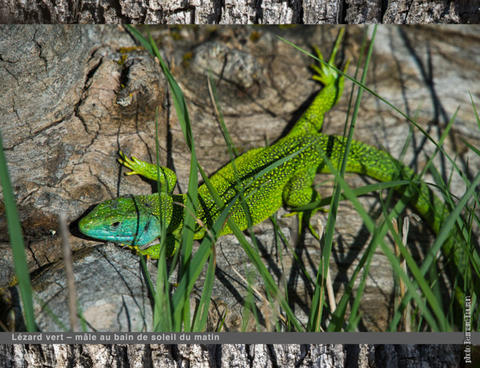
Lacerta viridis
LEZARD VERT – MÂLE AU BAIN DE SOLEIL DU MATIN
Aux premiers jours ensoleillés, les lézards sortent de leur hibernation. Les femelles pondent une dizaine d’œufs blancs au fond d’un trou creusé dans le sable ou la terre, bien exposé au soleil. Agile et rapide, il sait grimper dans les arbres.
A savoir : Il peut abandonner sa queue s’il se sent pris car, ensuite, elle va se régénérer.
GREEN LIZARD – MALE BASKING IN MORNING SUNSHINE
Lizards emerge from their hibernation with the first days of warm sunshine. Females lay about a dozen white eggs at the bottom of a hole dug into the sand or the soil, in a place well exposed to the sun. Quick and agile, lizards can climb trees. If they feel threatened, they can abandon their tails which will subsequently regenerate.
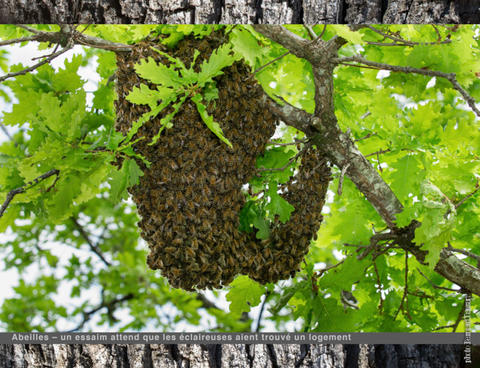
Apis mellifera
ABEILLES – UN ESSAIM ATTEND QUE LES ECLAIREUSES AIENT TROUVE UN LOGEMENT
Au printemps, la colonie populeuse se divise et la vieille reine s’en va avec une partie des ouvrières. Le groupe se pose en essaim serré autour de la reine tandis que des éclaireuses partent à la recherche d’une cavité où loger.
A savoir : Mortalité alarmante chez les abeilles.
HONEY BEES – A SWARM WAITING FOR ITS SCOUTS TO FIND THEM A NEW HOME
In Spring, the overpopulated colony splits up and the existing queen leaves with some of the worker bees. The group forms a swarm around the queen, while scouts set off to find a suitable cavity for them to colonize. The present rate of mortality among the bee population is increasingly alarming.
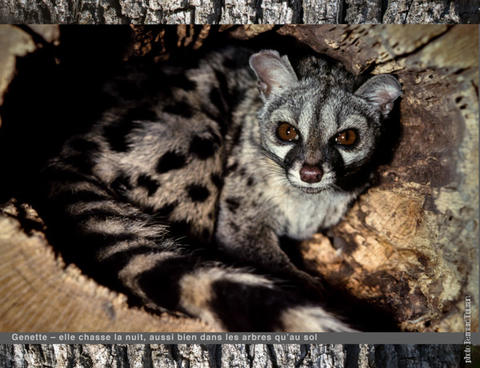
Genetta genetta
GENETTE – ELLE CHASSE LA NUIT, AUSSI BIEN DANS LES ARBRES QU’AU SOL
Excellente grimpeuse, elle circule pendant la nuit sur les talus et dans les arbres. Elle chasse à l’approche tout ce qui est plus petit qu’elle.
A savoir : Elle est très discrète, mais ses crottiers déposés en évidence sur un rocher marquent sa présence.
COMMON GENET – A NIGHT HUNTER, BOTH IN TREES AND ON THE GROUND
An excellent climber, circulates during the night on banks and in trees. Hunts any smaller prey. Very shy, but droppings left in full view on a rock face will betray its presence.
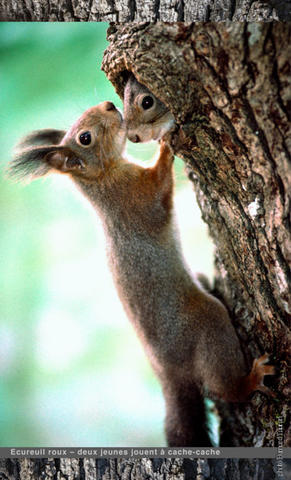
Sciurus vulgaris
ECUREUIL ROUX – DEUX JEUNES JOUENT A CACHE-CACHE
C’est un solitaire qui occupe ses journées à rechercher des graines, baies, fruits et bourgeons qui constituent sa nourriture. En automne, il stocke ses réserves dans des cachettes. Son pelage d’hiver le pare de longs pinceaux de poils sur les oreilles.
A savoir : Les boules de feuilles mortes qu’on voit en hiver en haut des arbres sont autant de nids d’écureuils à l’intérieur douillet tapissé de mousse.
RED SQUIRREL – TWO JUVENILES PLAYING HIDE AND SEEK
A solitary animal, spends its days looking for the seeds, berries, fruits and buds which make up its diet. In Autumn, excess food is hidden in caches. Its Winter coat includes long, pointed ear tufts. In Winter, bundles of dead leaves to be seen at the tops of trees are in fact squirrel dreys (nests) lined with a soft layer of moss.
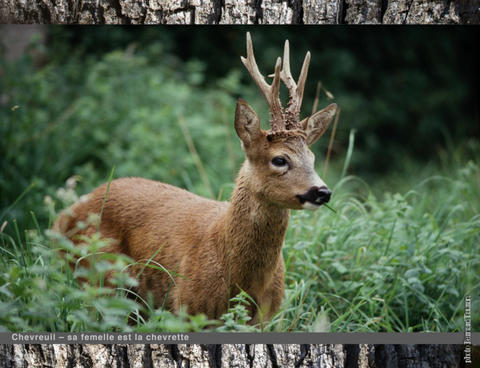
Capreolus capreolus
CHEVREUIL – SA FEMELLE EST LA CHEVRETTE
Seuls les mâles portent des bois qui tombent tous les ans au début de l’hiver. Les bois repoussent couverts d’un velours qu’ils éliminent en se frottant contre les écorces autour de mars-avril. Les chevreuils circulent surtout à l’aurore et au crépuscule.
A savoir : La femelle s’appelle la chevrette et non la biche qui est la femelle du cerf.
ROE DEER – MALES ARE BUCKS, FEMALES ARE DOES
Only males have antlers which they shed annually at the beginning of Winter. Antlers grow back covered with a thin layer of velvet-like fur which later disappears, a process helped by being rubbed against the bark of trees around March and April. Roe deer graze primarily at dawn and at dusk. The Bambi of the book by Felix Salten (1923) was originally a roe deer. In the Walt Disney cartoon film adaptation (1942) Bambi became a mule deer (Odocoileus hemionus),with the larger ears that lend it its name, more familiar to US viewers.
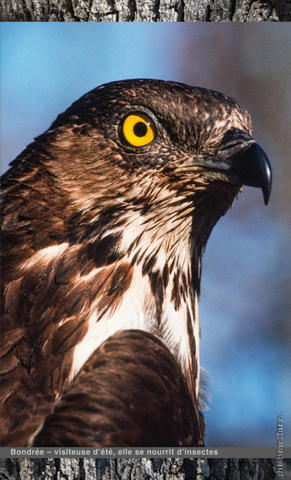
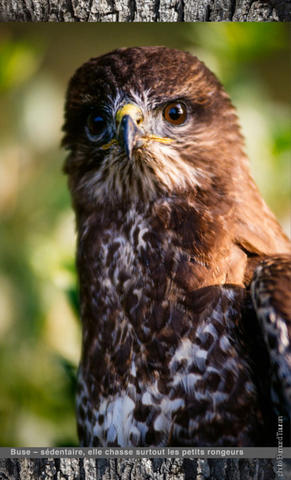
Pernis apivorus & Buteo buteo
BONDREE – VISITEUSE D’ETE, ELLE SE NOURRIT D’INSECTES
BUSE – SEDENTAIRE, ELLE CHASSE SURTOUT LES PETITS RONGEURS
Très semblables dans le ciel, ces deux rapaces ont des mœurs bien différentes. La bondrée n’est ici qu’en été et se nourrit surtout d'insectes alors que la buse est sédentaire et chasse diverses proies.
A savoir : La bondrée n’hésite pas à creuser avec ses serres pour déterrer les nids de guêpes.
HONEY BUZZARD (OR PERN) – A SUMMER VISITOR, FEEDING ON INSECTS
BUZZARD – A SEDENTARY HUNTER PRIMARILY OF SMALL RODENTS
Very difficult to distinguish in the sky, these two raptors (birds of prey) behave very differently. The Honey buzzard appears here only in the Summer and feeds mainly on insects, while the Buzzard is sedentary and hunts various prey. The Honey buzzard will happily use its claws to dig out wasps’ nests.
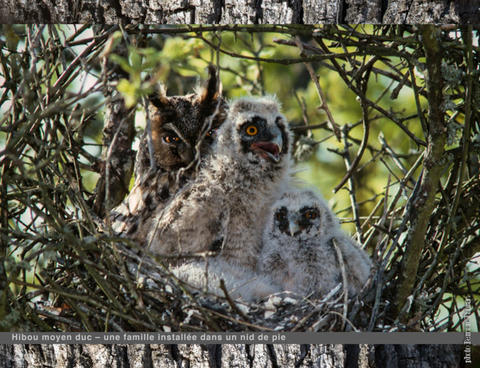
Asio otus
HIBOU MOYEN DUC – UNE FAMILLE INSTALLEE DANS UN NID DE PIE
Ce sont les appels lancinants des jeunes sortis du nid mais encore dépendants de leurs parents qui trahissent leur présence. Comme ses cousins petit et grand duc, sa tête s’orne d’aigrettes plumeuses qu’il dresse quand il est inquiet.
A savoir : C’est un chasseur très spécialisé dans les rongeurs qui s’installe en fonction des proies disponibles.
LONG-EARED OWL – A FAMILY INSTALLED IN A MAGPIE’S NEST
The piercing shrieks of chicks emerging from the nest but still dependent on their parents give away their location. Like its close relatives, the Scops owl and the Eagle owl, it has blackish ear-tufts, which stand erect when it is alarmed. A highly specialized hunter of rodents, will settle where its prey are plentiful.
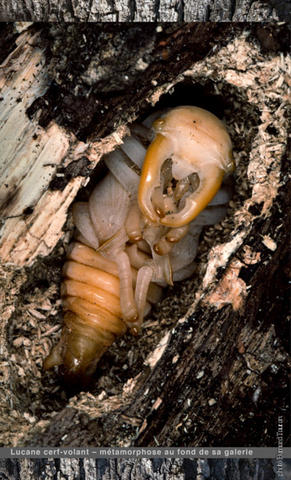
Lucanus cervus
LUCANE CERF-VOLANT – METAMORPHOSE AU FOND DE SA GALERIE
La larve, sous forme de ver blanc, se nourrit dans les souches où elle grossit pendant trois à cinq ans en creusant des galeries. Ensuite, dans une loge, elle entame sa transformation en insecte adulte qui, lui, ne vivra que quelques semaines.
A savoir : le plus imposant des insectes européens. Vol lourd et bruyant au crépuscule.
STAG BEETLE – PUPATING INSIDE A PUPAL CELL
The larva, which resembles a white worm, feeds on rotting wood, tunneling galleries and increasing in size for three to five years. It then pupates inside a pupal cell into the adult insect which will survive only a few weeks. The largest European insect, noted for its clumsy and noisy flight at dusk.
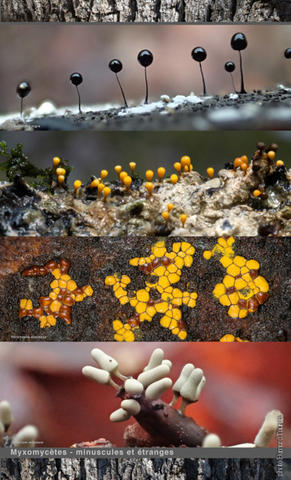
Comatricha nigra ; Arcyria cinerea ; Perichaena depressa ; Craterium minutum
MYXOMYCETES – MINUSCULES ET ETRANGES
Ces étranges organismes s’installent sur les bois en décomposition ou au revers des feuilles mortes de la litière des forêts. Ils changent de forme et de couleur tout au long de leur vie. Qui sont-ils ? Ni animal, ni végétal, ni champignon... ils n'ont pas fini de nous surprendre !
A savoir : Leurs formes, leurs couleurs, leurs transformations nous surprennent. Le seul problème, c'est de les trouver ! Ils sont si petits !
MYXOMYCETES – MINUTE AND MYSTERIOUS
Colloquially known as plasmodial or acellular slime moulds, these strange organisms appear on rotting wood or on the backs of dead leaves in forest litter. They change shape and colour throughout their life span. So what are they? Neither animal, nor vegetable, nor fungi… they never fail to surprise us! Their shapes, their colours, their mutations are astonishing. The only problem is finding them, given how tiny they are!
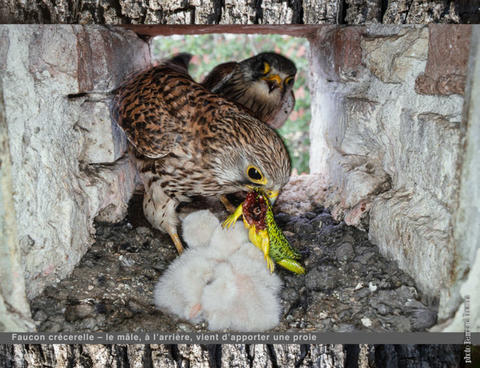
Falco tinnunculus
FAUCON CRECERELLE – LE MÂLE (A L’ARRIERE) VIENT D’APPORTER UNE PROIE
Il fait du vol sur place au-dessus des champs puis descend par paliers avant de fondre sur la proie qu’il a repérée au sol : petit rongeur, insecte ou reptile.
A savoir : Pour nicher, il a besoin de cavités en haut des murs. Pensons à lui en laisser quand nous rénovons les bâtiments anciens.
KESTREL – THE MALE (IN THE BACKGROUND) HAS JUST CAPTURED A PREY FOR HIS CHICKS
Kestrels can hover on the spot over open country and then descend in stages before swooping down on the prey they have spotted on the ground: a small rodent, insect or reptile. For nesting, they need holes at the top of walls. Remember to leave a few when restoring old buildings.
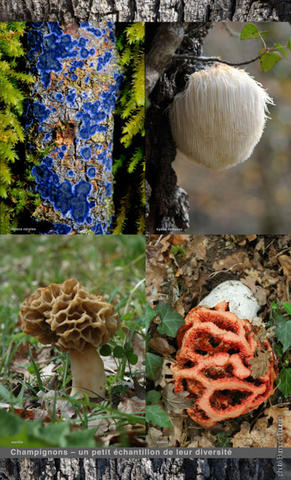
Terana cerulea (bleu), morille (brune), hydne hérisson (blanc), clathre (rouge)
CHAMPIGNONS – UN PETIT ECHANTILLON DE LEUR DIVERSITE
On connaît tous les cèpes, mais les sous-bois abritent une multitude de champignons de tailles, formes et couleurs très diverses.
A savoir : Par leur réseau souterrain (mycélium), les champignons participent activement à la vie de la forêt : circulation et échanges de nutriments entre eux et avec les autres végétaux, en particulier avec les arbres.
MUSHROOMS – A SMALL SAMPLE OF A VAST RANGE
Cobalt crust fungus (blue), Morcella or Morel (brown), Lion's mane mushroom (white), Stinkhorn (red)
We may be able to recognize the edible Boletus mushroom, but our woods are home to a multitude of mushrooms varying widely in size, shape and colour. Using an underground fungus-like bacterial colony (mycelium), mushrooms play an active part in the life of the forest, circulating and exchanging nutrients amongst themselves and other organic species, particularly trees.
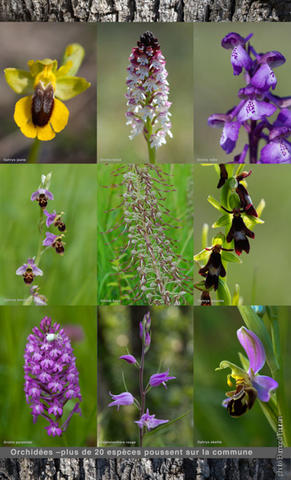
Ophrys insectifera, Ophrys apifera, Ophrys scolopax, Anacamptis pyramidalis, Orchis ustalata, Himantoglossum hircinum, Ophrys lutea, Cephalanthera rubra, Anacamptis morio
ORCHIDEES – IL Y EN A PLUS DE 20 ESPECES SUR LA COMMUNE
Ophrys mouche, Ophrys abeille, Ophrys bécasse, Orchis pyramidal, Orchis brûlé, Orchis bouc, Ophrys jaune, Céphalanthère rouge, Orchis bouffon.
A savoir : Ici, la plupart des orchidées vivent sur les pelouses sèches des collines. Parmi les plus remarquables, celles qui attirent les pollinisateurs en prenant leur apparence (Ophrys mouche, abeille, punaise, araignée, …)
ORCHIDS – MORE THAN 20 SPECIES ARE TO BE FOUND IN THIS COMMUNE ALONE
Fly orchid, Bee orchid, Woodcock orchid, Pyramidal orchid, Burnt orchid, Lizard orchid, Yellow bee orchid, Red helleborine, Green-winged orchid
In this region, most orchids are to be found on dry hillside grasslands. The most striking include those which attract pollinizers by mimicking their appearance (e.g. Fly orchid, Bee orchid , etc.)
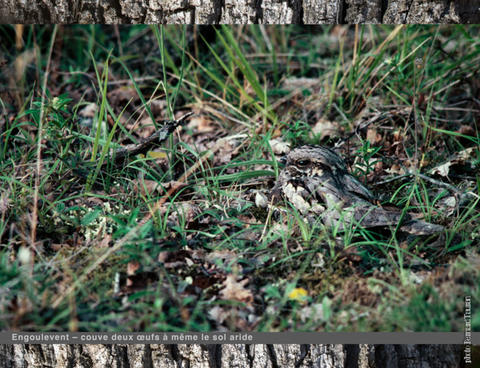
Caprimulgus europaeus
ENGOULEVENT – COUVE DEUX ŒUFS A MEME LE SOL
Oiseau crépusculaire qui chasse les insectes en volant le bec grand ouvert, tel un entonnoir. Immobile pendant la journée sur une branche ou au sol, son plumage couleur écorce le rend difficile à repérer.
A savoir : Il est ici pendant l’été et passe le reste de l’année au sud du Sahara.
NIGHTJAR – SITTING ON TWO EGGS LAID DIRECTLY ONTO BARE GROUND
Nocturnal or twilight birds, they chase insects flying with their beaks wide open, funnel-like. During daylight they perch immobile on a branch or on the ground. Their plumage is cryptically coloured (camouflaged) to resemble bark or leaves which helps to conceal them during the day. They spend their summers here, and the rest of the year south of the Sahara.
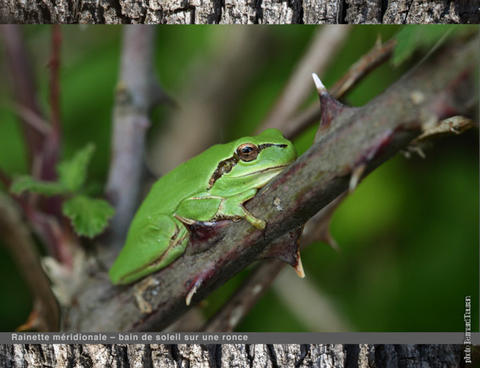
Hyla meridionalis
RAINETTE MERIDIONALE – BAIN DE SOLEIL SUR UNE RONCE
C’est une petite grenouille arboricole dont les doigts et les orteils sont terminés par des pelotes adhésives. Aux mœurs crépusculaires et nocturnes, on la repère au printemps grâce aux appels bruyants des mâles autour des points d’eau. D’octobre à février, elle hiberne.
A savoir : Elle est insectivore. En dehors de la saison de reproduction, elle s’éloigne de l’eau et peut élire domicile dans vos pots de fleurs
STRIPELESS TREE FROG – SUNBATHING ON A BRAMBLE
This small, tree-climbing frog has adhesive pads on the ends of its digits, front and back. Mainly nocturnal, in Spring it can be located by the loud calls of the males near sources of water. Hibernates from October until February. Insectivore. Outside the mating season, it moves away from the water and may choose to take up residence in your flower pots.
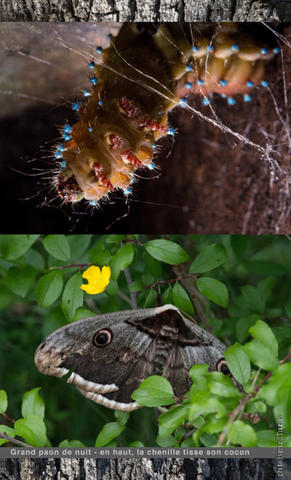
Saturnia pyri
GRAND PAON DE NUIT – LE PAPILLON et, en haut, SA CHENILLE TISSANT LE COCON
Ce papillon ne possède pas de trompe pour se nourrir et meurt quelques jours après la reproduction. Sa chenille, elle, vit de neuf à dix mois. Elle se nourrit de feuilles d’aubépine, prunelier, prunier et autres fruitiers.
A savoir : C’est le plus grand des papillons d'Europe.
GREAT PEACOCK MOTH – and (above) GREAT PEACOCK MOTH LARVA WEAVING ITS COCOON
This moth has no proboscis with which to feed and dies within a few days after reproduction. Its larvae, however, lives for nine to ten months, feeding on the leaves of hawthorn, sloe (blackthorn), plum and other fruit trees. The largest European moth.
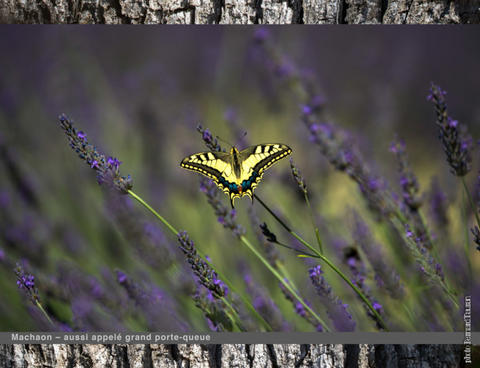
Papilio machaon
MACHAON AUSSI APPELE GRAND PORTE-QUEUE
Un de nos plus élégants papillons au vol plané et puissant. Sa chenille verte tachée d’orange et de noir, se nourrit sur les ombellifères tel le fenouil. Elle hiberne sous forme de nymphe à l’intérieur d’une chrysalide attachée à une tige par une ceinture de soie.
A savoir : La chenille déploie un organe répulsif malodorant de couleur vive quand elle se sent agressée.
OLD WORLD [or COMMON YELLOW] SWALLOWTAIL
One of our most elegant butterflies, with its powerful, gliding flight. The caterpillar, which is green with orange and black markings, feeds on umbelliferous plants such as fennel. Hibernates in nymph form inside a chrysalis attached to a twig by a silk sling. It has a defense against predators in the form of an osmeterium, which consists of retractable, fleshy projections behind its head that can release a foul smell if disturbed.
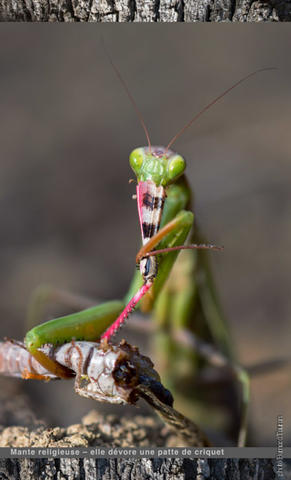
Mantis religiosa
MANTE RELIGIEUSE – ELLE DEVORE UNE PATTE DE CRIQUET
Insecte diurne qui chasse à l’affût et capture ses proies dans ses pattes avant ravisseuses. La femelle pond en automne environ 200 œufs dans une oothèque*, où ils passent l’hiver. Il est exact que la femelle dévore souvent le mâle pendant l’accouplement.
A savoir : l’oothèque, de forme ovale, ressemble à de la mousse de polyuréthane beige. Elle est collée à un support rigide.
PRAYING MANTIS – FEEDING ON THE LEG OF A GRASSHOPPER
This diurnal insect hunts live prey, which it locates by sight, and then grasps in its spiked forelegs (“raptorial legs”). In the autumn, the female lays about 200 eggs in an ootheca, where they will spend the winter. It is a fact that the female does often devour the male during mating. The oval-shaped ootheca resembles beige polyurethane foam, and is attached to any firm surface.
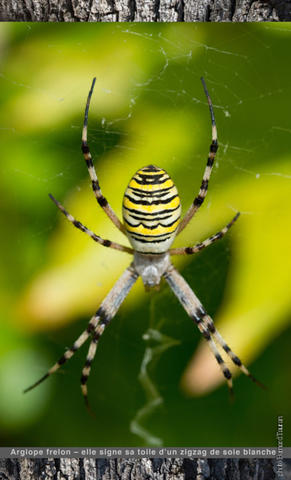
Argiope bruennichi
ARGIOPE FRELON – ELLE SIGNE SA TOILE D’UN ZIGZAG DE SOIE BLANCHE
Elle se tient au centre de sa toile, ses pattes prêtes à interpréter la moindre vibration des fils de soie, pour fondre sur les gros insectes qu’elle emmaillote dès qu’ils sont piégés. Elle fabrique une urne de soie brune qui contient sa ponte.
A savoir : Elle grossit durant toute sa vie et il n’y en a pas deux avec des dessins identiques.
WASP SPIDER – DECORATES ITS WEB WITH A ZIGZAG PATTERN OF WHITE SILK
Waiting in the middle of its web, its legs are poised to detect the least vibration of the silk threads, and then pounce on large insects, quickly immobilizing them by wrapping them in silk as soon as they are trapped. Makes a large urn-shaped silk cocoon for her eggs to over-winter. Continues to increase in size throughout its lifetime. No two have the same markings.
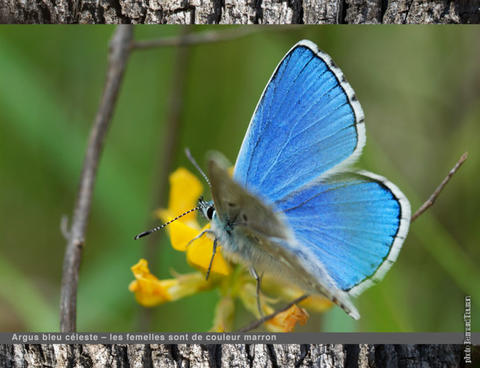
Lysandra bellargus
ARGUS BLEU CELESTE – les femelles sont de couleur marron
Le bleu intense caractérise le mâle. Le dessous de ses ailes est d’un discret brun tacheté de noir et d’orange, des couleurs semblables à celles des femelles. C’est un petit papillon qu’on trouve en groupe sur la terre humide ou volant rapidement de fleur en fleur dans les friches.
A savoir : Il existe de nombreuses espèces d’Argus et autres Azurés qui se ressemblent beaucoup.
ADONIS BLUE – BUT THE FEMALES ARE BROWN…
Males are characterized by their vivid blue colour. The underside of its wings are a soft brown, with black and orange markings, similar to those of the female. This small butterfly can be found congregating on humid soils or darting from one flower to another in uncultivated areas. There exist many species of Adonis and other “blues” all looking very similar.
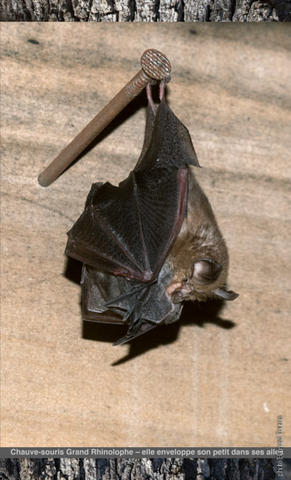
Rhinolophus ferrumequinum
CHAUVE-SOURIS GRAND RHINOLOPHE – ENVELOPPE SON PETIT DANS SES AILES POUR LA TETEE
Cette chauve-souris a un seul petit par an qu’elle enveloppe ici pour la tétée. Elle hiberne dans des grottes ou caves profondes, souvent à plusieurs dizaines de kilomètres de son territoire d’été. Quand la nuit tombe, en été, elle chasse des insectes volants.
A savoir : Peut vivre 30 ans mais ses populations chutent dramatiquement.
GREATER HORSESHOE BAT – A FEMALE SUCKLES HER OFFSPRING HIDDEN INSIDE HER WINGS
This bat produces only one offspring per year; here she is letting it feed, shielding it with her wings. Hibernates in deep caves, often many dozens of kilometers from its Summer territory. At nightfall in the summer time, hunts flying insects. Can live 30 years, but its populations are currently falling dramatically.
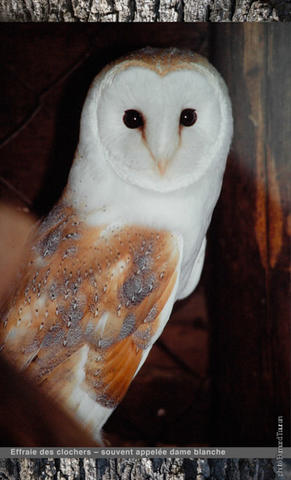
Tyto alba
EFFRAIE DES CLOCHERS – Souvent appelée Dame Blanche
La nuit elle va se poster sur un perchoir, immobile, pour chasser les mulots, campagnols et autres petits mammifères. Elle les détecte grâce à une vision nocturne et une ouïe exceptionnelles.
A savoir : greniers, clochers, granges, sont ses gites et il est important de ne pas lui en interdire l’accès.
BARN OWL – in french often called the white lady (dame blanche)
Perches without moving on branches, posts or other lookouts, while hunting field mice, voles and other small mammals, which they locate using their night vision and exceptionally acute hearing. As cavity nesters, they prefer attics, church towers, barns etc. and it is important not to block their access to these.
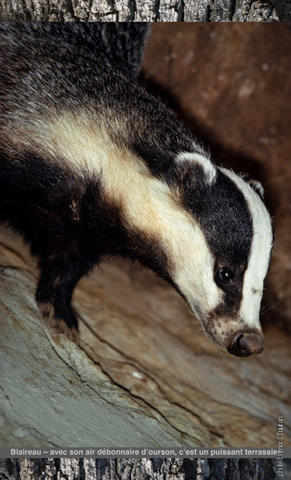
Meles meles
BLAIREAU – AVEC SON AIR DEBONNAIRE D’OURSON, C’EST UN PUISSANT TERRASSIER
Ce pépère omnivore fait toujours ses randos nocturnes sur les mêmes traces qui forment un réseau bien marqué. C’est un terrassier très costaud qui vit avec son clan dans de vastes terriers, de vrais labyrinthes de couloirs et de chambres à entrées multiples.
A savoir : Partageur, il héberge parfois des renards ou autres lapins. Très mauvaise vue.
BADGER – ITS TEDDY BEAR APPEARANCE MASKS A POWERFUL UNDERGROUND DIGGER
The omnivorous « Mr. Badger » always follows the same path on his night time rounds, forming an easily identifiable network. Capable of extremely powerful digging, he lives with his clan (or cete) in vast burrows known as sets, veritable labyrinths of corridors and multiple entry chambers. Sometimes happy to share his set with foxes, or rabbits. Very poor sight.
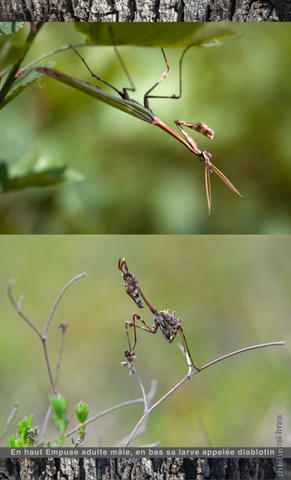
Empusa pennata
EMPUSE - ADULTE MÂLE et, en haut, SA LARVE APPELEE DIABLOTIN
Elle a l’allure frêle du phasme, les armes d’une mante et une tête de monstre de science-fiction. Les œufs éclosent à la fin de l’été pour donner naissance à des diablotins qui passeront l’hiver à ce stade larvaire, se nourrissant à peine. Au mois de mai, ils prennent la forme adulte.
A savoir : Vit dans les endroits secs et ensoleillés ; très difficile à repérer.
CONEHEAD MANTIS - ADULTE MALE and, top, ITS LARVA, KNOWN AS AN “IMP”
These phasmids (from the Ancient Greek phasma, meaning an apparition or phantom) with their frail bodies, their mantis-like limbs and their monstrous sci-fi heads, hatch from their eggs as “imps” which then pass the winter in this larva phase, barely feeding. In May, they take on their adult form. Lives in dry, sunny areas; very difficult to spot.